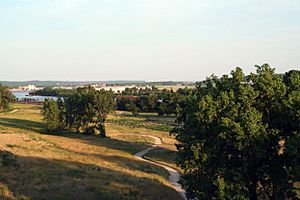Bruce Vento Nature Sanctuary facts for kids
Quick facts for kids Bruce Vento Nature Sanctuary |
|
|---|---|

The Bruce Vento Nature Sanctuary looking toward the Mississippi River
|
|
| Location | Saint Paul, Minnesota, USA |
| Created | 2005 |
| Operated by | St. Paul Parks and Recreation |
The Bruce Vento Nature Sanctuary is a special city park in Saint Paul, Minnesota. It's right next to the mighty Mississippi River. This amazing place has huge cliffs made of limestone and sandstone, which are over 450 million years old! You can also find wetlands fed by springs, lots of different birds, and fantastic views of downtown Saint Paul and the river. The park opened on May 21, 2005. It was named after Bruce Vento, a U.S. Representative who helped make the park possible.
Contents
A Long History: From Ancient Times to Today
The land where the sanctuary sits has a very long and interesting story. It was once a flat area where two creeks, Phalen Creek and Trout Brook, flowed into the Mississippi River.
Native American Heritage
Native people used and valued this land for thousands of years. It was home to Wakan Tipi (Spirit House), a sacred Dakota site. This place is also known as Carver's Cave.
In 1766, an explorer named Jonathan Carver visited the site. He wrote about the cave and the Dakota people. He described carvings on the stone, calling them "strange hieroglyphics." Carver even marked the cave with the King of England's symbol.
Carver's book, Travels through the Interior Parts of North America (1778), made Wakan Tipi famous. Early settlers wanted to see it. But over time, falling rocks covered the cave's entrance, and it was lost.
Changes to the Land
In 1837, the Dakota people agreed to give up their lands east of the Mississippi River. This was part of a big expansion by early Americans. Fourteen years later, the Mdewakanton Dakota also gave up their lands west of the river.
After the Dakota people moved, European immigrants began to use the land. It became a place for farming and then for industries. The North Star Brewery was built into the bluff in 1853. Later, it became Jacob Schmidt's first brewery.
In the 1880s, the land was used for railroads. Sadly, this led to the destruction of the ancient Wakan Tipi rock carvings.
Creating the Sanctuary
The land was left empty in the 1970s. Then, in 2005, different groups worked together to buy the 27 acres (11 ha) area. It officially became a Saint Paul city park.
In 2008, another 1.85 acres (0.75 ha) of nearby industrial land was added to the park. Today, the sanctuary's forests, woodlands, and prairies are being carefully brought back to their natural state. The park is recognized for its mix of natural beauty and cultural history. It's also known for how much the community helped make it happen.
Who Helps Manage the Sanctuary?
The City of Saint Paul owns and runs the Bruce Vento Nature Sanctuary. It's also part of the National Park Service's Mississippi River and Recreation Area.
Many groups help take care of the park. The Lower Phalen Creek Project is a community group that helps with restoration, volunteer activities, and teaching people about the park. They work with Historic Saint Paul.
The Trust for Public Land helped buy the land for the park. Young people from the Community Design Center of Minnesota's East Side Youth Conservation Corps also help. They restore the park's nature and act as student naturalists.
Local neighborhood groups, like the Dayton's Bluff Community Council and Friends of Swede Hollow, are also very involved. They help with the sanctuary and the nearby Swede Hollow Park.
There are plans to build a path for walking and biking that connects directly to the Mississippi River. There are also ideas to build a visitor center and other park-related areas next to the sanctuary.

